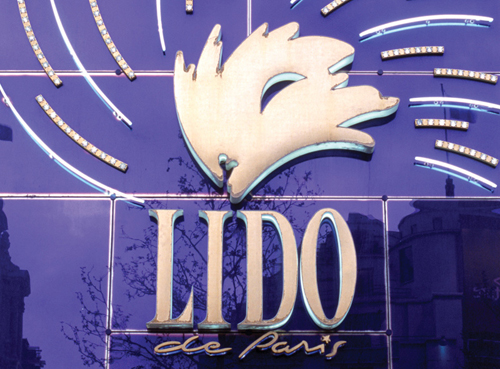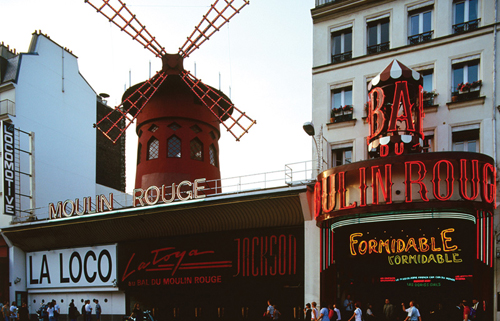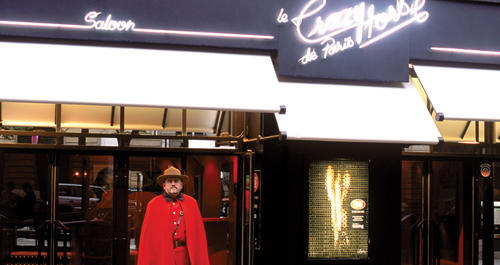Opéra National de Paris Garnier Not
just a night out, but a whole experience, opera has now returned to its
original Paris base after the theatre had a spell as a dance-only
venue. The vast stage can hold a cast of 450, and the building itself is
an example of excessive opulence, complete with grand staircase,
mirrors and marble . Folies-Bergère The
epitome of Parisian cabaret, the Folies were, for a time, no more than a
troupe of high-kicking, bare-breasted dancers. Today, the musical shows
have largely returned to the nostalgic days when Maurice Chevalier and Josephine Baker performed here. 32 rue Richer, 75009 08 92 68 16 50
The Lido Home
to the world famous troupe of long-legged dancers, the Bluebell Girls,
the fabulous special effects include aerial ballets and an on-stage
skating rink. There are many who regard this dinner-cabaret as an
essential Parisian experience.

The Lido
Moulin Rouge The original home of the Can-Can, the theatre’s dancers were immortalized on canvas by Toulouse-Lautrec during the belle époque and are on display in the Musée d’Orsay. The show still has all the razzamatazz that has been dazzling audiences since 1889. The pre-show dinner is optional .

Le Crazy Horse Paris
More risqué than
the other big-name cabaret shows, the Saloon has a reputation for
putting on the most professional as well as the sexiest productions.
Striptease features, along with glamorous dancing girls and other
cabaret acts. The computer-controlled lighting effects are spectacular.

Le Crazy Horse Paris
Le Cirque d’Hiver Worth
visiting for the freshly renovated façade alone, this whimsical
150-year-old building plays host to the traditional Cirque Bouglione,
complete with trapeze artists and tame tigers. Comédie Française Paris’s
oldest theatre was founded in 1680 and is still the only one with its
own repertory company, staging both classical and modern drama (in
French). The current building dates from the 18th century. Around the
corner from the main box office, a special window opens 45 minutes
before curtain-up, selling reduced price tickets for under-27s and
concessions.
Opéra National de Paris Bastille
Opened in 1992 as the largest opera house in the world, this
modern building was heavily criticized, not least for its acoustics and
poor facilities. However, this is still the best place to see opera in
Paris.
Théâtre du Châtelet The
city’s largest concert hall and fourth-largest auditorium was built in
1862. The repertoire covers classical music, ballet and opera, as well
as popular Sunday morning chamber music concerts. Théâtre de la Ville Once
known as the Sarah Bernhardt Theatre, in honour of the great Parisian
actress who performed here and managed the theatre in the 19th century,
today it puts on an eclectic range of modern dance, music shows and some
classical theatre.
Top 10 Films set in Paris
Les Enfants du Paradis The city’s underworld is shown in this 1944 classic. Everyone Says I Love You Woody Allen’s 1996 movie included many scenes shot around Notre-Dame and the Left Bank. A Bout de Souffle French New Wave director Jean-Luc Godard’s 1959 film stars Jean-Paul Belmondo as a car thief on the run. French Can-Can The Jean Renoir classic (1955) tells the story of how the famous dance was created in Montmartre clubs. Last Tango in Paris Controversial, erotic 1972 film starring Marlon Brando. The Trial Orson
Welles used the then empty Gare d’Orsay (now the Musée d’Orsay) to
create a convincingly huge and anonymous office for his 1962 version of
Kafka’s novel. Subway The metro was the star in this 1985 Luc Besson film about a man who seeks refuge at night in its stations. Les 400 Coups Gritty Paris streets feature in this 1959 François Truffaut film about a boy on the run. Amélie Jean-Pierre Jeunet’s 2000 sensation about a girl’s quest for love features numerous scenes in Montmartre. Prêt-à-Porter Robert Altman takes a satirical look at the Paris fashion industry in his 1995 film.
|